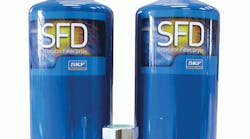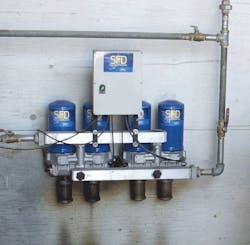Most engineers, maintenance technicians, and plant managers recognize that clean, dry compressed air increases uptime and productivity of pneumatically powered equipment. Removing water, contaminants, and oil vapor from the air improves the performance, reduces the need for maintenance, and extends the life of cylinders and valves. And it ensures high product quality and eliminates defects when air is used as part of a manufacturing or packaging process. However, traditional desiccant and refrigeration air dryers can be bulky, costly, and maintenance intensive.
The Separator Filter Dryer (SFD) from SKF USA Inc., Lansdale, Pa., is said to overcome these drawbacks. The compact, 3-in-1 system incorporates a dual-cartridge design that removes water vapor, oil, and contaminants from compressed air. Desiccant and filters are housed within two spin on/off cartridges.
A desiccant dries air by adsorbing moisture and holding the water on its surface. Adsorption involves adhesion of water molecules to the desiccant surface. This differs from absorption, which involves molecules dissolving or diffusing into the absorbent material, where they are not easily removed.
The drying process in the SFD is similar to that in heatless, twin-tower desiccant dryers. Control valves channel flow through one cartridge to remove water from the air while the second cartridge is offstream for regeneration – the process of removing adsorbed water from the desiccant. Regeneration in the SFD involves passing a small quantity of the dried
air through the offstream canister, which picks up water from the desiccant surface and then is safely vented to the surroundings.
The basic SFD typically requires less than 10% of air for regeneration and handles flow rates up to 40 cfm. However, these modular units can be connected in tandem to accommodate flow rates up to 800 cfm – and a 1600-cfm version will be introduced soon. The SFDachieves a pressure dewpoint as low as -40°F, though actual dewpoint depends on system flow and pressure.
A significant feature is the unit’s small size. The complete SFD measures only about 14.5-in. wide, 21-in. high, and 10.5-in. deep. The compact system can be discretely installed directly on an air tank, compressor top plate, or nearby wall.
Standard units operate at pressures up to 180 psi. An optional internal filtration/oil separator system also removes oil and filters out contaminants as small as 0.1 micron. The SFD can be specified with or without internal filtration for 5, 7.5, 10, 15, and 20-hp applications.
The SFD comes in three different models. The basic version relies on a Micro Logic Timer that switches flow to the cartridges every two minutes. PLC control is offered for larger set-ups with more cartridges and higher flows, typically 120 cfm and above. In an SFD with four cartridges, for example, three are drying the air while one is regenerating at any one time. These units simply plug into a standard 12 or 24 Vdc or 120 Vac power source.
In locations where electricity can be a hazard, a pneumatically controlled version relies on an air-logic timer circuit to direct air flow to the appropriate cartridges.
The SFD provides a reliable and versatile drying option, able to accommodate a range of air system requirements and flow rates. It’s commonly used in conjunction with large air compressors and systems, treating a compressed air stream directly from the tank and eliminating the need for aftercoolers, additional external filters, and related equipment. The SFD dryer can also mount on small air compressors or at point of use, such as in spray booths and work stations.
The unit provides uninterrupted air treatment, even in dirty or dusty conditions, and can operate in high or low ambient temperatures. This makes it suitable for use in a wide variety of industrial applications, ranging from concrete manufacturing plants, warehouse operations, and amusement parks to automotive paint booths, CNC machining centers, and food and beverage processing. In fact, the SFD is currently used throughout SKF manufacturing facilities.
Canisters with good upstream filtration and an oil separator will reportedly last at least two years, and well-maintained units have operated efficiently for more than five years. Should replacement be necessary, the cartridges can typically be changed in a matter of minutes. Units can be serviced without disassembling or removing them from their mountings.
Information for this article was provided by Tom Mahoney, SFD Program Manager, SKF USA. Contact him at (847) 742-0700, email [email protected], or visit www.skfusa.com.


